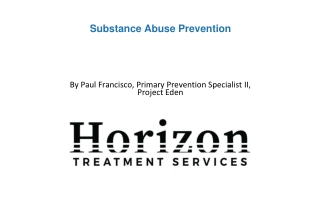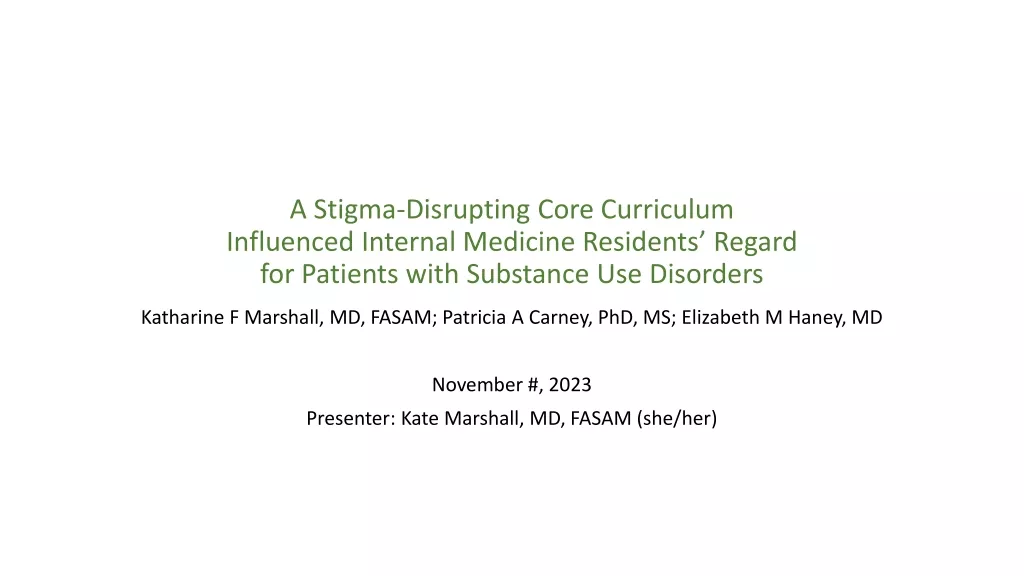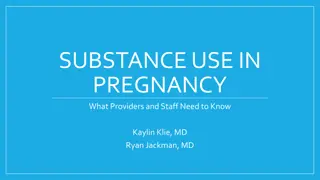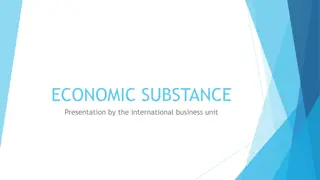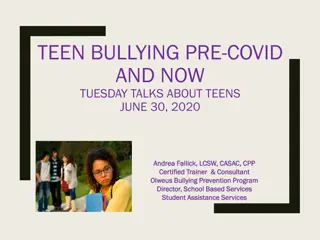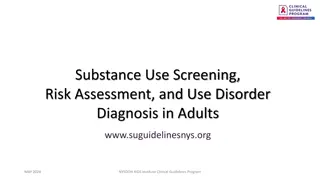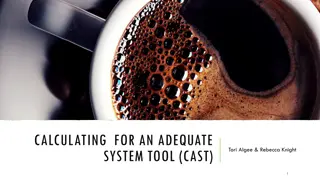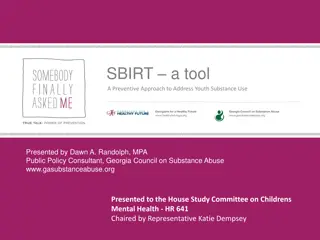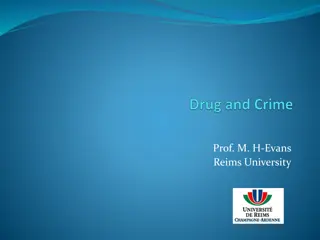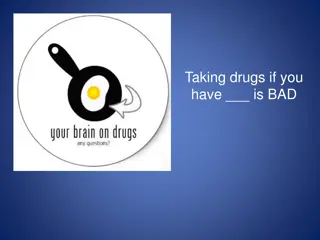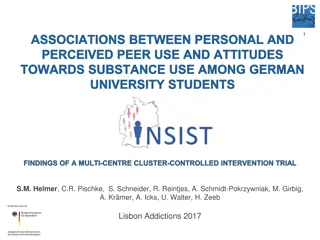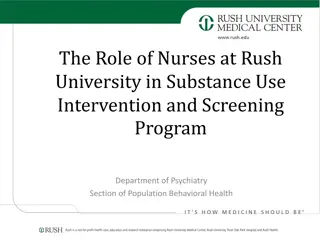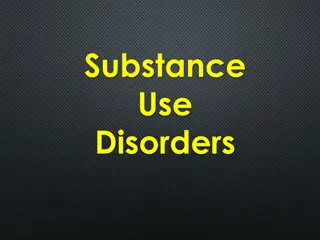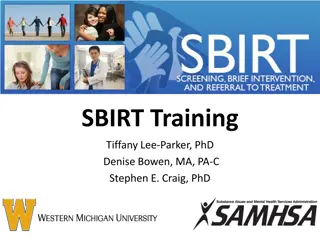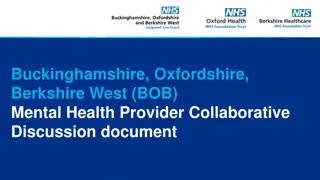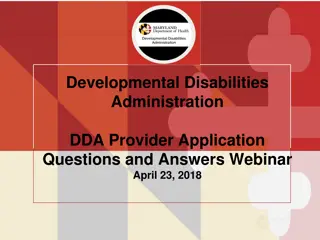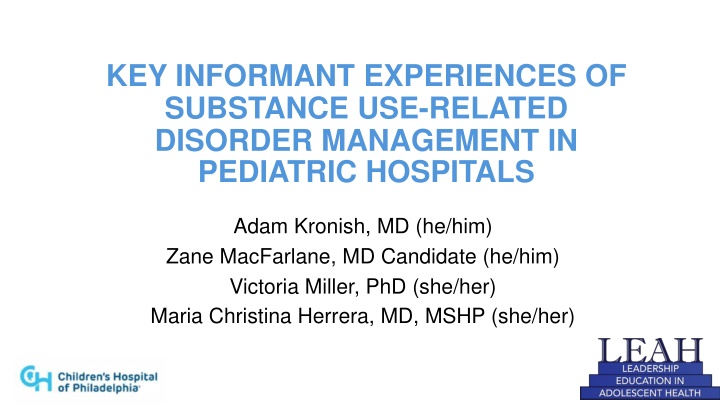
Pediatric Hospital Management of Substance Use Disorders: Insights & Challenges
Explore the landscape of substance use disorder treatment in pediatric hospitals, focusing on adolescents and young adults. Learn about the research aim, recruitment process, and methods used to shed light on facilitators and barriers to care.
Download Presentation

Please find below an Image/Link to download the presentation.
The content on the website is provided AS IS for your information and personal use only. It may not be sold, licensed, or shared on other websites without obtaining consent from the author. If you encounter any issues during the download, it is possible that the publisher has removed the file from their server.
You are allowed to download the files provided on this website for personal or commercial use, subject to the condition that they are used lawfully. All files are the property of their respective owners.
The content on the website is provided AS IS for your information and personal use only. It may not be sold, licensed, or shared on other websites without obtaining consent from the author.
E N D
Presentation Transcript
KEY INFORMANT EXPERIENCES OF SUBSTANCE USE-RELATED DISORDER MANAGEMENT IN PEDIATRIC HOSPITALS Adam Kronish, MD (he/him) Zane MacFarlane, MD Candidate (he/him) Victoria Miller, PhD (she/her) Maria Christina Herrera, MD, MSHP (she/her)
Support and Disclosures No relevant financial relationships or disclosures Diversity/Equity Statement: Our authors make up a diverse group of racial, ethnic and sexual identities underrepresented in medicine. Sources of Support: o This project was supported by the Health Resources and Services Administration (HRSA) of the U.S. Department of Health and Human Services (HHS) under T71MC30798 Leadership Education in Adolescent Health (LEAH), the Craig Dalsimer Division of Adolescent Medicine at the the Children's Hospital of Philadelphia (CHOP), and Clinical Addiction Research and Education (CARE) Program (NIDA: R25DA03582). o This information or content and conclusions are those of the authors and should not be construed as the official position or policy of, nor should any endorsements be inferred by HRSA, HHS, NIDA, or the U.S. Government.
Children's Hospitals and Substance Use 4 4/13/2025
The Research Question Case reports/series describe individual institutions' experiences with care around specific substances There is not yet a description of what happens in children's hospitals more broadly Study Aim: to characterize the current state of substance use disorder (SUD) treatment for adolescents and young adults (AYAs) in pediatric hospitals and elucidate facilitators and barriers of care What does care related to SUD in children's hospitals look like across the country and can we identify areas of improvement in substance- related care? 4/13/2025 5
Recruitment 12 physicians from 9 academic children's hospitals in urban centers All receive funding through the MCHB Leadership Education in Adolescent Health grant Mix of adolescent medicine, addiction, and child/adolescent psychiatry providers
Methods Interview Guide Study on Addiction Consult Services by Priest & McCarty 2019 summarized responsibilities of addiction services in adult hospitals 4 domains of coding: 1) Education and Training 2) Clinical services 3) Systemic and Institutional Factors 4) Culture & Stigma Qualitative Data Analysis Semi-structured, key-informant interviews recorded and transcribed Double-coding and thematic analysis was conducted to consensus and saturation Member checking with 2 non- LEAH addiction medicine providers with expertise in AYA care
Descriptive Findings Of the 9 institutions represented: Outpatient SUD Services o 5 offer outpatient support for SUDs o 2 offer no outpatient support for SUDs o 2 offer limited support or is done through non-pediatric specialty Inpatient SUD Services o 6 offer inpatient support for SUD o 3 offer variable amounts of support o None had zero support Disciplines involved: o All adolescent medicine, SW, psychiatry o Variability across institutions of other medical and non-medical disciplines
Descriptive Findings Psychosocial Services Offered Inpatient (n and % of institutions who reported that the service was offered)i Medical Services Offered Inpatient (n and % of institutions who reported that the service was offered) Buprenorphine/Suboxone/Sublocade (7, 78%) Benzodiazepines (7, 78%) Nicotine replacement (7, 78%) Symptomatic medications (7, 78%) Naltrexone (3, 33%) Psychotropic medications (3, 33%) N-acetylcysteine (2, 22%) Social work (9, 100%) Psychology (6, 67%) Case Management (4, 44%) Child life services (3, 33%) Other behavioral health (3, 33%) Art/Music/Animal therapy (3, 33%) Chaplaincy (2, 22%) Family Relations (1, 11%) Resource specialists (1, 11%) Risk Reduction Clinic (1, 11%)
Qualitative Themes Insufficient Training & Experience Medical Needs > SUD Pathways/Algorithms Access to Care Systemic Factors Legal Factors Institutional Factors Attitudes towards SUD and AYAs Lack of Data in Peds Increasing Needs & Underrecognition Champions promote positive change
Themes and Quotes "I think there's probably provider uncertainty about what diagnosis to use. Many providers aren't trained to make DSM 5 diagnosis of that pertain to substance use, and so they're more comfortable putting in a general diagnosis, nausea and vomiting, something like that." Insufficient Training & Experience
Themes and Quotes "So the current state is kids are admitted for a medical reason and then the addiction is something that we manage as a correlate to that so that they can reach their treatment goals from the medical problem" Clinical Pathways & Algorithms Medical problems prioritized over SUD
Themes and Quotes "Rightnow when we're asking for resourcesfor addiction-related treatments from the health system, the answer we often get is that the need isn't that high and he need isn't that high and therefore therefore it's hard to justify it's hard to justify, you know, paying full time equivalents for staff when the need isn't that high. My caveat to that is I I think think that data collection for substance that data collection for substance use related use related issues is very, very limited issues is very, very limited because oftentimes those [ ]substance use related diagnosis aren't placed in the problem list [ ]And I think that the data we have are probably under reporting that." Access to Care Systemic Factors Legal Factors Institutional Factors Lack of Data in Peds
Themes and Quotes some pediatric residents are really into youth, and some are really into babies and not into adolescent issues and don't really don't want to ask [about substance use]" Attitudes towards SUD and AYAs I think people are realizing this is something we need to do much, much better pediatric hospitals all over the country, they're like we have had overdoses, we've had deaths in our community. We need to do this and, like, please tell us where to start. And so there's a huge interest there Increasing Needs & Underrecognition Champions promote positive change
Key Study Findings: High degree of variability in care - individual, institution, geography, discipline No standard of AYA SUD care & lack of consistent data Culture & stigma around adolescents, young adults and addiction impact medically necessary care oDifferences between the intersectional identities of inpatient providers and their patients may impact systems of care; just as stigma related to SUD adds barriers to care, so too does systemic oppression. More education, training, institutional support and data have high potential for positive change
Limitations All are academic children's hospitals in urban centers oPotentially more resources oNot where all children/adolescents get their inpatient care Sample of providers were self-designated and recruited via adolescent medicine leadership development grant oOverrepresentation of adolescent medicine providers when others may provide addiction care (addiction medicine, family or internal medicine, child/adolescent psychiatry, etc.)
Next Steps Explore feasibility of national survey of children's hospitals oMay utilize pediatric hospitalist network Quantify and develop training and education oNeeds assessment of adolescent medicine fellowships oCurricular development at CHOP: clinical pathway and Motivational Interviewing for Trainees Continue to advocate for inclusion of youth in policies and guidelines related to SUD
Acknowledgements Appreciation to our colleagues, mentors, and role models in addiction and adolescent medicine at the Children's Hospital of Philadelphia and University of Pennsylvania Thank you to AMERSA for including the voices of pediatricians and adolescent specialists! Contact Information: Kronisha@chop.edu

